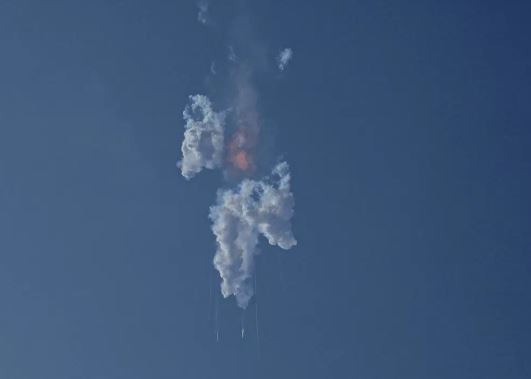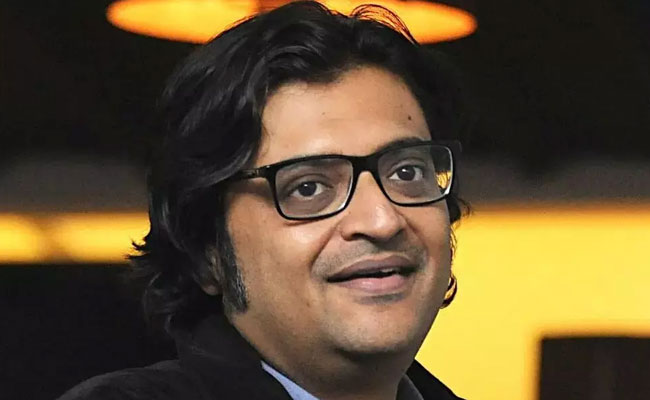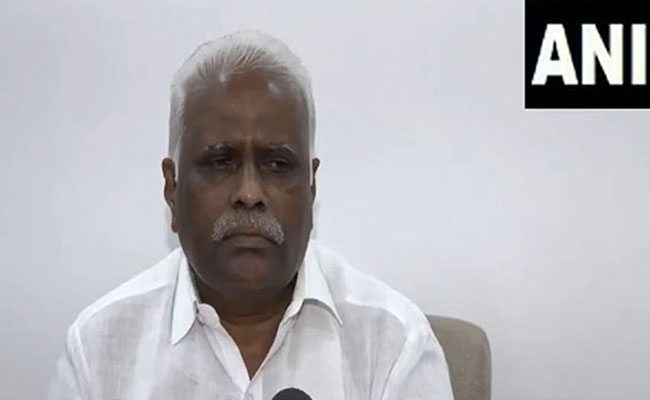South Padre Island, Apr 20: SpaceX's giant new rocket exploded minutes after blasting off Thursday on it first test flight and crashed into the Gulf of Mexico.
Elon Musk's company was aiming to send the nearly 400-foot (120-meter) Starship rocket on a round-the-world trip from the southern tip of Texas, near the Mexican border.
It carried no people or satellites.
Images showed multiple engines weren't working on the 33-engine rocket as it climbed from the launch pad, reaching as high as 24 miles (39 kilometers.)
The flight plan had called for the booster to peel away from the spacecraft minutes after liftoff, but that didn't happen.
The rocket began to tumble and then exploded four minutes into the flight, plummeting into the gulf.
After separating, the spacecraft was supposed to continue east and attempt to circle the world, before crashing into the Pacific near Hawaii.
Throngs of spectators watched from South Padre Island, several miles away from the Boca Chica Beach launch site, which was off limits. As it lifted off, the crowd screamed: "Go, baby, go!"
Musk, in a tweet, called it "an exciting test launch of Starship! Learned a lot for next test launch in a few months."
In the weeks leading up to the flight, Musk gave 50-50 odds that the spacecraft would reach orbit.
The company plans to use Starship to send people and cargo to the moon and, eventually, Mars.
NASA has reserved a Starship for its next moonwalking team, and rich tourists are already booking lunar flybys.
It was the second launch attempt. Monday's try was scrapped by a frozen booster valve.
At 394 feet and nearly 17 million pounds of thrust, Starship easily surpasses NASA's moon rockets past, present and future.
The stainless steel rocket is designed to be fully reusable with fast turnaround, dramatically lowering costs, similar to what SpaceX's smaller Falcon rockets have done soaring from Cape Canaveral, Florida. Nothing was to be saved from the test flight.
The futuristic spacecraft flew several miles into the air during testing a few years ago, landing successfully only once.
But this was to be the inaugural launch of the first-stage booster with 33 methane-fuelled engines.
SpaceX has more boosters and spacecraft lined up for more test flights. Musk wants to fire them off in quick succession, so he can start using Starships to launch satellites into low-Earth orbit and then put people on board.
Starship Super Heavy has experienced an anomaly before stage separation! 💥 pic.twitter.com/MVw0bonkTi
— Primal Space (@thePrimalSpace) April 20, 2023
Let the Truth be known. If you read VB and like VB, please be a VB Supporter and Help us deliver the Truth to one and all.
New Delhi: In a striking turn that surprised even his regular viewers, Arnab Goswami spent the evening of December 4 taking direct aim at the central government over the ongoing crisis in the domestic aviation sector. The debate, aired on Republic, focused entirely on the severe disruption caused by IndiGo flight cancellations and the state of air travel in the country. The tone was sharp, emotional, and openly critical, raising the larger question of whether this marks a homecoming of sorts for the anchor long accused by critics of being soft on the government.
Goswami began the show by saying the central government had “completely let down” air passengers. He pointed to chaotic visuals from airports in Pune, Ahmedabad and Mumbai, describing passengers packed into crowded spaces, long queues, and travellers lying on the floor with little access to basic facilities. He said anyone travelling with children or elderly parents would understand the distress such situations cause.
According to him, the government often claims to have improved the aviation sector, but the day-to-day experience of passengers tells a different story. He argued that whatever help the government may have extended has benefited individuals and individual companies, not the sector as a whole.
Goswami highlighted data from the last three days, saying IndiGo had canceled 1,232 flights in November. He broke down the reasons for the cancellations: 755 linked to crew and FDTL constraints, 258 due to airspace and airport restrictions, 92 because of failures in air traffic control systems, 127 for other reasons.
He said passengers in India are often “taken for granted” and that only in this country can such large-scale cancellations take place without consequences.
Throughout the debate, Goswami repeatedly returned to the theme of duopoly. He said Air India and IndiGo together control 91.5 percent of the aviation market, leaving only a small share for others like Akasa and SpiceJet. This, he said, gives the two big players the power to decide prices and escape accountability.
“They can set the prices. They can torture passengers. They can be not answerable for air crashes.” He added.
Goswami also questioned why such a structure is allowed to exist if the government claims it opposes monopolies. He asked whether the government has made Air India accountable after the recent air crash, and said he did not believe so.
“We are told that the Modi government does not like monopolies. First of all, I don't agree with that. There are too many monopolies happening.” He said.
The anchor accused Air India of operating aircraft that were not airworthy and said no serious action followed. According to him, any other minister in charge of civil aviation would have been removed after such incidents, but nothing happened.
“He is not answerable. And why is the central government not bothered about it? Because he comes from the TDP, an alliance party. So let him do,” he said.
He added that Air India continues to seek government support, including compensation for losses after the Sindhur episode. Goswami questioned why public money should be used to support the airline, drawing a comparison with the earlier controversy involving Vijay Mallya seeking help from the Manmohan Singh government a move that was labelled as scam.
Goswami said passengers are suffering because of delayed flights, sudden cancellations, and lack of compensation. He criticised the DGCA, saying it was not enforcing safety and operational norms. He also questioned why the Prime Minister’s Office had not intervened.
He noted that Republic had carried multiple exposés on these issues and claimed that Air India chooses to give interviews and advertisements only to other channels.
He also called for Parliament to debate the aviation mess and examine whether monopolies or duopolies should be allowed in a nation of India’s size.
“I'm sure the government's not going to be happy with us saying this, but someone's got to speak up for the people of this country.” He added.
Known by his critics as the “Godi Media Chief”, Goswami’s direct attack on the Modi government over civil aviation raised eyebrows across media circles.
Whether this is a one-off outburst or a sign of a new editorial direction is something viewers will be watching closely.
#AviationCollapse | India’s aviation sector is in turmoil as IndiGo’s mass cancellations and Air India’s alleged safety lapses leave passengers stranded. The disruption raises serious questions about airline management, regulatory oversight, and who is ultimately responsible for… pic.twitter.com/Dqt6pcoW8w
— Republic (@republic) December 4, 2025





